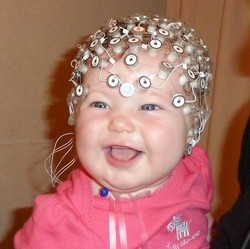They Sleep Like Babies in the Infancy Studies Laboratory at RU-N
On Nov. 2, 2017, Rutgers University–Newark (RU-N) celebrated the opening of Life Sciences Center II, a $59 million, state-of-the-art, science facility that serves as the hub of RU-N’s sciences quad. Nestled among the five-building complex is Aidekman Hall, home of the Center for Molecular and Behavioral Neuroscience (CMBN), where groundbreaking research on brain development in humans is taking place.
Dr. Sue Peters, a member of the Infancy Studies Laboratory led by Dr. April Benasich, has the enviable job of studying brain rhythms of infants during sleep. With a $450,000 grant from the National Institutes of Health and a nearly $100,000 grant from the Kavli Institute for Brain and Mind, Peters uses high resolution sensor technology, known as dense EEG (dEEG), and analytic techniques to measure sleep as a biomarker (or measurable indicator) of brain maturation in typically developing babies.
Sleep patterns appear to play a role in almost all known psychiatric disorders, which often parallel mental deficits. Studying brain rhythms during sleep at the millisecond and millimeter scale can lead to a better understanding of its role in human cognition and behavior while awake.
“We’ve been perfecting our methods for several years to conduct cross-sectional and longitudinal studies of infants at ages three, six, and nine months,” states Peters. “Given the speed at which babies change and the speed at which their behavior develops, infancy is an ideal time to study brain rhythms during sleep in humans.”
The cross-sectional studies collect, analyze, and characterize data from a group of babies at a given point in time, while the longitudinal studies gather, examine, and define data from a particular baby over a period of time.

With the dEEG data, gathered using a stretchy hairnet embedded with 124 wet, sponge-like sensors that slips onto an infant’s head, Peters maps the changes in two sleep brain rhythms: slow waves and sleep spindles, along with changes in spontaneous sleep patterns, and cognitive, motor, and social-emotional development.
With a goal of establishing a baseline of sleep brain rhythms for typically developing babies, Peters’s research is the first step toward developing future interventions for babies and ultimately adults. Slow waves, for example, may be a key component to understanding the development of brain-based disorders including schizophrenia, depression, ADHD, autism, and some chronic pain disorders like fibromyalgia.
Peters applies broad acceptance criteria to infants included in her studies. “We accept any baby who is not premature, did not experience any delivery complications, and does not have epilepsy,” Peters notes. If known, infants also are excluded where there is evidence of first-generation sleep disorders, autism, or ADHD. Having a family member with one of these disorders places an infant at higher risk of developing such a disorder, and specific brain rhythms during sleep are likely to be different in these higher risk groups. Peters’s long-term goal is to understand developmental sleep differences in some of these at-risk populations, but must first characterize the patterns in a low-risk population to understand typical brain development.
“We canvass Greater Newark and northern New Jersey for a diverse pool of participants, as well as Rutgers students and alumni, and find that the parents who participate really enjoy the interaction with our experienced lab members and learning more about their child’s brain development.” As vice president of the Graduate Student Government Association, Peters was actively involved in bringing graduate students together across disciplines, and this also gave her several opportunities to share and promote the work to graduate students expecting children. “We also continue to recruit within the Rutgers community, on both the Newark and New Brunswick campuses.”
While Peters’s interest in the brain began as a teenager, she developed a passion for sleep research after coping with a sleep disorder that affected her cognition. She was diagnosed with fibromyalgia in 1996, at age 22, when little was known about the condition, which involves widespread chronic pain, disrupted sleep (including slow wave brain rhythms), and cognitive deficits. After initially treating the condition with medication, she learned how to enhance her sleep using various methods including dietary changes and exercise, which resulted in improved sleep and cognition. Her personal experience with the effects of sleep on cognition sparked her passion for understanding the relationship between sleep and cognition.
Peters joined the Infancy Studies Laboratory in 2012 after her first year as a doctoral student in CMBN, and on Sept. 6, 2017, she successfully defended her thesis, "Dense Array EEG Measures of Infant Sleep: Microstructure and Topography as Biomarkers of Cognitive Development." Peters earned a bachelor’s degree in computer science from the City College of New York and spent 15 years working in mobile computing before pursuing her doctoral degree in neuroscience at RU-N. She was able to apply her background as the co-founder of a startup company, Braindock, which developed the first software app store for mobile devices in 2001, to her research passion for a better understanding of sleep and cognition. In her first year as a graduate student at RU-N, she worked with Dr. Mark Gluck and Dr. Itamar Lerner to study sleep and cognition in healthy college students using mobile devices. Her collaboration with this team led to the research being funded by the National Science Foundation Smart and Connected Health program. Peters continues to apply this line of work to her infant research and hopes elucidation of the brain and autonomic sleep rhythms across development will impact greatly understanding of sleep and mental health across the lifespan.